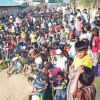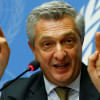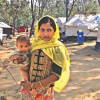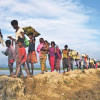Violence at Home, Insecurity Here, Uncertainty Ahead

The violent persecution of the Rohingya, which has displaced almost a million people from Myanmar to Bangladesh in recent months, represents one of the worst humanitarian disasters the world has ever seen. Médecins Sans Frontières (Doctors Without Borders) estimates that at least 7,000 people have been killed as a result of the violence that began earlier this year. Hundreds of thousands more have lost their homes, livelihoods, and dignity. I recently concluded a trip to the border region where I had gone to investigate and better understand the causes, consequences, and nature of violence the Rohingya have endured. The brutality and scale of suffering is hard to imagine but undeniable. Rohingya refugees' massive influx into Bangladesh echoes that of Bengalis' mass exodus to India some 46 years ago. The horrors that Rohingya men, women, and children have suffered serve as painful reminders of Bangladeshis' bloodstained quest for self-determination including, notably, the trauma of sexual violence and the multitude of gender-based insecurities.
Widespread sexual violence against women and girls
Sexual violence in armed conflict has existed for millennia but it is far from an inevitable occurrence.1 In 2008, the UN Security Council adopted Resolution 1820 that, for the first time, recognised rape as a weapon of war and called for concerted efforts to prevent its occurrence as well as to ensure accountability for its perpetration. The Secretary General's Report pursuant to that resolution cited sexual violence against Muslims in Rakhine state as a persistent problem of international concern.2 Beyond Myanmar, scholars increasingly acknowledge that rape, and other forms of sexual violence, may be committed in a variety of ways by armed actors in order to humiliate victims, terrorise their families, weaken communal ties, socialise combatants, retaliate for other attacks, and change demographic characteristics of a population.3 The government of Myanmar refutes allegations of rape and other human rights abuses. According to Pramila Patten, UN Special representative of the Secretary General for Sexual Violence in Conflict, Aung San Suu Kyi would not entertain “any substantive discussion” in recent meetings on the sexual violence that soldiers, border security forces, and Rakhine militias have committed against the Rohingya.4 Testimonies of refugees, however, tell an altogether different story.
In the violence that has engulfed northern Rakhine since August 2017, sexual violence appears to be a deliberate, prevalent, and severe form of targeting that Rohingya women and girls have suffered. It is difficult to ascertain, let alone verify, exact figures but victims' accounts suggest that the overwhelming majority of women were themselves subjected to sexual assault or know someone who was. Published reports by journalists and human rights organisations such as Human Rights Watch,5 as well as my own fieldwork, indicate that gang rape has not only been a common part of the Burmese military's repertoire of abuse but also one that fits into a broader ethnic cleansing agenda. My preliminary analysis of sexual violence against Rohingya in the context of the Myanmar military's “clearance operations”6 reveals patterns similar to those observed during the bloody breakdown of the former Yugoslavia in the 1990s and Bangladesh's liberation war.7 The tatmadaw claims to be fighting a counterinsurgency campaign to eliminate Rohingya militants, just as West Pakistan's military claimed to do against Bengali separatists in 1971, but the violence uncannily resembles an all-out extermination effort with sexual violence a central feature.
Rohingya women have told of being raped in front of their family members as well as taken away from their homes and brutalised by groups of soldiers. It is yet to be seen how many babies will be born from these rapes and how they will fare in a world where to be a Rohingya is to be persecuted, banished, and friendless. Mothers recount their children, some newborns, being thrown into open fires. Many of the children who have made it to Bangladesh are unaccompanied, some separated from their parents while others saw their families slaughtered in front of their own eyes.

Gendered insecurities in refugee camps
As forcibly displaced persons, women and girls face a range of insecurities in the camps scattered throughout Ukhia and Teknaf. Although safe from armed belligerents in Myanmar, they are vulnerable in new ways. Intimate partner violence, for example, is a growing concern, its occurrence all too common in high-stress and post-traumatic situations. Unmarried women I spoke to also complained about sexual harassment within the camps from members of their own community. The Rohingya are an extremely conservative society in which girls are typically married off almost immediately after they reach puberty whereas unmarried teenage girls are shamed and shunned, expected to remain out of sight and away from the male gaze. Early and forced marriage is therefore also an issue amongst the refugee population. At the same time, the fertility rate amongst the Rohingya—who previously lacked access to contraceptives and family planning awareness—is very high, which has consequences for maternal and neonatal health. Inadequate clean water and easily accessible sanitation arrangements also cause discomfort, especially for the pregnant, heighten risks for catching communicable disease; and leave women and girls vulnerable to assault, especially when latrines are far away or lack lights and locks. These are just some of the issues discussed at the women friendly spaces that international humanitarian aid and domestic non-governmental organisations are running, which serve as places for women to gather, enjoy respite, and obtain useful information. Similarly, sessions specifically targeting adolescent girls are also being held at child friendly spaces scattered throughout several camps to raise awareness about hygiene, healthy relationships, and personal safety. Programmes like these help mitigate some of the difficult circumstances in which women and girls find themselves but they do not fully protect participants from the varied security risks they confront. Moreover, despite growing efforts, the gap between need and supply with respect to this type of programming remains wide.
Trafficking—of persons, drugs, and arms—is also a major concern, one that has distinct gendered implications. During my trip, I met a young woman in Kutupalong refugee camp who had fallen prey to traffickers. Approximately a month after her arrival in Bangladesh, a woman known to she and her parents lured her out of the camps with the promise of a well-paying job in Cox's Bazar. Naïve, desperate, and destitute, she trusted this woman who took her to a non-descript building, locked her inside a room, and funneled men to her bed who visited her day and night, having their way with her. A sheltered virgin, the young woman went into shock and became manic. After a week of this harrowing ordeal, with her mental and physical condition dramatically deteriorating, the young woman was returned to her parents in the camp and given 500 taka for her troubles. Now she spends her days and nights in the ramshackle tarp-covered hut, hiding herself away from the sun, people's whispers, and the leering eyes of other potential predators.
Looking forward: trauma, healing, and legacies of mass violence
One need not look farther than Bangladesh's own history to know the long lasting, intensely painful, and complicated legacy of mass violence, especially rape and other forms of sexual violence. All too often, women's lived experiences of conflict are hidden in the shadows of public imagination or they are politicised by elites who—even if well meaning—may do more harm than good. The silencing and sequestering of sexual violence victims can worsen trauma or ignite new and other forms of individual and collective anguish.
To counter social stigma, which is common in the aftermath of conflict-related sexual violence, the acceptance of rape victims by their communities is critically important. Community leaders, including imams, will have a salient role to play as lessons from Iraq and Bosnia demonstrate. Ceremonies were held recently in the Yazidi holy site of Lalish to welcome back former ISIS sex slaves after a declaration—akin to a fatwa—was issued by the faith's supreme leader Baba Sheikh on the reintegration of recovered women and girls.8 Similarly, in 1993 while fighting continued in Bosnia, a spiritual leader and jurist, Ahmed Mesic, wrote an open letter to raped women offering support and calling for victims' rehabilitation.9 Memories of sexual abuse and exploitation run deep; their trauma is exacerbated by social scorn. Women raped during conflict, like those in Bangladesh, Iraq, Bosnia, Myanmar, and far too many other places, deserve care and understanding. They also deserve justice.
While it may seem premature to talk of accountability for human rights abuses at a time when the Burmese military continues to raze Rohingya villages, it is important to heed lessons learned from experiences elsewhere on documentation of abuses and collection of testimonies. If future criminal accountability efforts are to be feasible, the care, meticulousness, and due process with which evidence is gathered and preserved today will surely be consequential. The Rome Statute of the International Criminal Court specifies rape, sexual slavery, enforced prostitution, forced pregnancy, enforced sterilisation, and any other form of sexual violence as crimes against humanity and war crimes punishable under international law.10 Legal precedents exist in both domestic and international prosecutions that could pave the way for future cases involving rape against the Rohingya but these, if ever, are unlikely to happen any time soon. Until then, structured, sustained, and victim-centric access to psychosocial services will be paramount for the well being of not just women and girls who were raped but the future of Rohingya society generally.
***
Mayesha Alam is a Global Health Justice Fellow at Yale Law School and a doctoral candidate in political science at Yale University. She is the author of Women and Transitional Justice (Palgrave Macmillan 2014).
Notes:
1 Elisabeth J. Wood, "Armed groups and sexual violence: When is wartime rape rare?." Politics & Society 37, no. 1 (2009): 131-161.
2 United Nations Security Council, “Report of the Secretary-General pursuant to Security Council resolution 1820 (2008),” S/2009/362*, 20 August 2009.
3 Dara K. Cohen, "Explaining rape during civil war: Cross-national evidence (1980–2009)." American Political Science Review 107, no. 3 (2013): 461-477.
4 Poppy McPherson, “Aung San SuuKyi 'avoided' discussion of Rohingya rape during UN Meeting,” The Guardian, 27 December 2017.
5 Human Rights Watch, “'All of My Body Was Pain': Sexual Violence against Rohingya Women and girls in Burma,” 2017.
6 Oliver Holmes, Katharine Murphy, and Damien Gayle, “Myanmar says 40% of Rohingya villages targeted by army are now empty,” The Guardian, 23 September 2017.
7 Lisa Sharlach, "Rape as genocide: Bangladesh, the former Yugoslavia, and Rwanda." New Political Science 22, no. 1 (2000): 89-102.
8 Emma Graham-Harrison, “'I was sold seven times': the Yazidi women welcomed back into the faith,” The Guardian, 1 July 2017.
9 Riada A. Akyol, “When Victims of wartime Rape are Scorned,” The New York Times, 18 December 2017.
10 United Nations General Assembly, Rome Statute of the International Criminal Court, 17 July 1998.

 For all latest news, follow The Daily Star's Google News channel.
For all latest news, follow The Daily Star's Google News channel. 








Comments